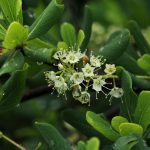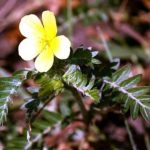TREE LIFE
NOVEMBER 1993
MASHONALAND CALENDAR
Tuesday 2nd November : Botanic Garden Walk. Park at the Herbarium where we will meet Tom Muller at 1645 hours for 1700 hours
Saturday 13th November : The Aloe, Cactus and Succulent Society have invited interested members to join them for a talk on growing indigenous plants/trees from seed. Kerry Wallace from “Emerald Seedlings” will give the talk at the nursery where a wide variety of plants will be on sale.
Sunday 21st November : Roy and Pam Guthrie have established a game/safari area on near Glendale and have kindly invited us to visit them for our November trip. It is some years since we visited the Glendale area, and we anticipate an interesting day.
Saturday 27th November : Meet at 3 pm for Mark’s Botanic Interest Walk. Take the Borrowdale Road, turn left into Harare Drive. We will meet about 500 meters down the road where the tar ends and the gravel begins.
Sunday 5th December : A combined Christmas social with the History Society at Chedgelow Farm
Mark’s Walk : Date to be advised.
MATABELELAND CALENDAR:
Saturday 7th November : The First Acacia School. Meet at Girls‘ college for an 0830 hours departure. Please be prompt. You might find it useful to bring along a clip board and a pen or pencil. As we will be providing hand-outs please phone Ian or Margaret confirm your attendance. This will ensure that we print enough material. Also bring tea things and chairs for afterwards.
Monday 8th November : Urban Trails, Hillside Dams at 1645 hours for 1700 hours
Sunday 5th December : The Second Acacia School, with arrangements as for the first one.
Monday 13th December : Urban Trails.
Saturday 1st January : Our New Years Day social at the Raubs.
Sunday 2nd January : By special request a return to Roy Stevens‘ property, Shumba Shaba Makulu in the eastern Matopos.
BOTANIC GARDEN WALK 5TH OCTOBER, 1993
With many trees bursting into flower and leaf, the Tree Society led by Tom Muller walked through the Gardens, looking at anything of interest.
The first tree we examined was a flowering Vangueriopsis lanciflora (fami1y RUBIACEAE) with a very long style and stigma. Tom mentioned how the stigma remains receptive to pollination after the particular flower has ceased producing pollen, in order to enhance the likelihood of cross-pollination. It was noted how superficially similar the flowers and the leaves are to Turraea nilotica (family: MELIACEAE).
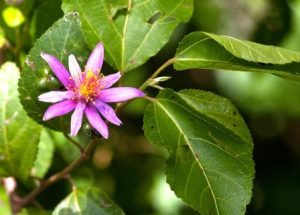
Grewia occidentalis. Photo: Bart Wursten. Source: Flora of Zimbabwe
Nearby was the purple-flowered Grewia occidentalis (family TILIACEAE). In Zimbabwe, this is confined to forest edges at medium altitudes in the Eastern Districts.
On round the forest edge, we looked as we have done many times before at the Crabia brevicaudata, covered in spectacular white pea flowers on this occasion. This species generally sticks its flowers out of the canopy in order to be pollinated.
Two species of Rhigozum were in flower in the Gardens. Both had yellow flowers but were very different in general appearance. R.zambesiacum has pinnate leaves, each leaf with 3 to 5 pairs of leaflets, plus a terminal leaflet. R.brevispinosum, on the other hand, has fascicles of simple leaves. Both species occur in hot dry areas at low altitudes and can at times be covered with yellow flowers. Around Harare, a species of the cultivated genus, Tabebuia, which belongs to the same family (BIGNONIACEAE) does the some thing.
Another lowveld species examined was Sterculia roggrsii, with swollen, almost succulent stems, a mottled trunk and flaking bark. The species of the genus Sterculia lack petals, the petal-like objects are in fact the lobes of the calyx. This particular tree was in full flower, its calyx yellowish-green with red markings.
A specimen of Cassia abbreviata still had many yellow flowers – why is the specific name “abbreviate”? This refers to the inflorescence, which is relatively short or abbreviated.
One of the most shapely tree species in the Gardens is Acacia abyssinica, the Nyanga flat-top. The two trees we looked at were planted in 1966 and originated from Kenya. These trees are exceptionally wide in relation to their height — do they perhaps, represent a different race to our native trees ? Once again, our thanks go to Tom for sharing his knowledge with us.
-Mark Hyde
SUNDAY 3 OCTOBER : VISIT T0 THE BULAWAYO HERB GARDEN.
A warm and informative greeting from Mr Moyo, Chairman of the Medicinal Plant Protection Group, He started off the interesting first part of a double outing. Saying he was very happy that our Society was taking an interest in the African side of medicine and healing, he hoped a lot more people would become involved. The garden is in the Museum grounds, originally the home of a small zoo — the cages being retained as segmented areas of the nursery where a tremendous amount of effort is producing a wide range of indigenous ‘Muti’ trees and shrubs.
Then Mr Mlapisane, the coordinator conducted us on a tour of the nursery. He spoke of herbalist customs. In most cases the root of the tree is the medium required and judicious cutting must be observed. The old African tradition was to cut from East to West, and never from North and South, but today this rule is not always being kept and so the total destruction of the tree, bush or plant. This is the reason for starting the Plant Protection Group and for growing new trees from seed.
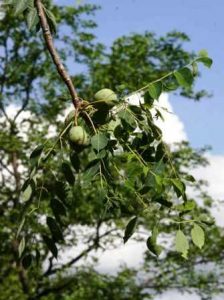
Sclerocarya birrea. Photo: Bart Wursten. Source: Flora of Zimbabwe
One of Africa’s most important medicinal herbs is the marula Sclerocarya birrea grown easily by placing the pointed end of the pip into the soil. The seeds (nuts) contain a rich oil protein for food and also is used as a cosmetic. The bark which is often seen stripped is a cure for diarrhoea and dysentry.
The roots of Azanza garkeana are boiled and used as a relief for coughing and the mucilage from the fruits is used in childbirth.
A variety of Lonchocarpus capassa from Botswana has larger softer leaves and does not grow to the same height as the local variety. This tree can be pruned and provides a natural medicine for animals – often browsed. Smoke from the burning roots is inhaled to relieve colds and ‘flu.
The reason that most Elephantorrhiza goetzei growing in inaccessible places between rocks is that all the others that were growing in open ground have already been collected for ‘Muti‘ the roots being used to cure constipation and weak bladders – very popular.
Euphorbia espinosa – paper barked milk bush is another popular muti herb. The boiled root cures people who feel really ill but can’t describe what is wrong.
The fruits of Mimusops zehheri provide an important food supplement rich in vitamin ‘C’ and are a cure in themselves. The flowers are used for stomach ailments.
In Flacourtia indica the fruit is used to cure eye problems and infections and a bark infusion is for pneumonia, whereas an infusion of the bark of Berchemia zeyheri is taken orally for internal pains.
Time proved too short to look at all the trees growing in the nursery but this project is a start to save the trees from vandalism and eventual destruction by herbalists. The theory of the group is that if each herbalist is encouraged to grow his own trees and herbs, he will take particular care of them and use them with descretion and cut only sufficient for his immediate use. Schools too are beingencouraged to use this nursery for obtaining young trees and shrubs and also to learn about traditional medicine. Some useful editions relating to these remarkable efforts may be obtained at the Library, Trust House, Fort Street, 14th Avenue.
Mr Mlambo, horticulturist, in his closing address stressed the importance of gathering and growing seeds and needs some advice and expertise in the germimation of some species as their results have not always proved successful. He also touched on the problem of finance to further this project on a much larger scale throughout the country and so save our trees – a very worthy cause which needs to be encouraged.
-KEN HARTLEY
NATURAL DYES FROM TREES – SUNDAY 3 OCTOBER, 1993
We arrived at Mabukuweni just after 10.30 am to find June Davies already installed with her boxes of dyed wool samples and an intriguing hay-box, cardboard covered with tin foil, shiny side out, and insulated within with discarded wool. It was complete with dye-pot, glass and a tin-foil covered hinged lid for directing the sun’s rays on to the glass. This she uses to heat her mordants and dyes and so save on the ever-rising costs of electricity.
The natural wool yarn comes from her own sheep and she holds week-end courses on wool preparation, spinning and weaving.
Wool is very easy to dye with natural dyes, but because it is a sensitive fibre, care must be taken with the cleaning and dyeing process. Mordants are used to make the wool more receptive to the dyes and also to improve colour fastness. By adding a different mordant to the same dye-plant you can get different shades and colours which always blend harmoniously together – very subtle differences which enhance June’s wall-hangings.
Her most used mordant is ALUM but other chemicals are COPPER SULPHATE, POTASSIUM DICHROMATE, FERROUS SULPHATE, CREAM of TARTAR and BICARBONATE of SODA. Use of these various chemicals can sadden (deepen) the colour. You dissolve the chemical in a little hot water and put this into the container for mordanting. Fill the container with cold water and place into it the dampened wool skeins. Heat the water to boiling point and keep at this temperature for two or three hours. Allow to cool before removing wool. Before the actual dyeing process can begin the collected dye-plant material must be out up or crushed and then soaked in water for two or three days, brought to the boil and boiled from one to six hours depending on the strength of the material – roots only need to be simmered.
Wool skeins must be wet before adding to the dye-bath. Add sufficient cold water to cover and bring dye-bath to the boil for one or two hours. Keep stirring and testing till desired shade is reached.
Let container cool as this strengthens the colour and then rinse skeins thoroughly in cold water.
June uses the 2 – 1 ratio as a rule and she also uses the process of over-dyeing, that is mixing her dyes to achieve the desired colour.
She then showed us samples or dyed wools – three or four variations in the same dye – bath using different mordants and the differences and blends were quite amazing and always in harmony.
Rhus lancea leaves produce yellow to khaki shades; Croton gratissimus rich earthy colours; Dichrostachys cinerea a yellow; Berchemia discolor varying shades of purple, pink, orange and brown. June was thrilled when the pods of Acacia karroo gave her the nearest to black she has yet achieved, but she was disappointed with her results in using Marula, Sclerocarya birrea bark. Her dyes using Indogofeera erecta were sometimes brilliant and oft times indifferent – never consistent in achieving those elusive blues and June is still wanting help in getting a true rose madder. Trees can contain the dyestuff in the leaves, bark, roots, pods, fruit, seeds or flowers, the latter strangely enough not often although their colours are bright. Care should be taken in the collection of these so as to preserve and never to destroy.
Lichens and moss need no mordant. June collects the former from trees, never from rocks because of their slow growth rate. These produce orange, brown, yellow and green shades.
Of the herbs blackjack, Bidens pilosa and Khalki bush, Taggetes minuta produce bright orange, yellow and green and the Amaranthus species give a greenish range. June has even collected and used the cochineal insects from Prickly Pears, Opuntia ficus indica, in her search for pinks.
Thank you June for a well prepared and informative talk giving us yet another outlet in our study of trees.
-Thora Hartley
BALKIZA 17 OCTOBER 1993
A breeze kept the already warm day bearable as we followed a well worn path up the hill to the rock paintings.
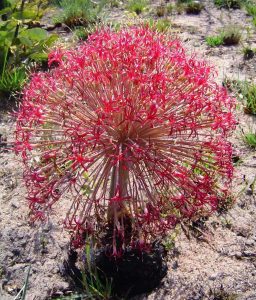
Boophane disticha, Photo: Bart Wursten. Source: Flora of Zimbabwe
A scattered colony of Boophane disticha, with pale pink orb-like inflorescences, brought us to a halt as Trance mentioned that eating the bulb results in a “high” where everything becomes extremely funny not easy to imagine as in the surrounding Brachystegia woodland recently hatched cicadas screeched from almost every branch sounding like hundreds of electric drills all running flat out. Near the saddle between the two kopjes a dried out watercourse had in its confines Syzygium cordatum, Clerodendrum wildii with bright purple petioles on the new leaves and on the rock a Cassine aethio ica supporting itself on the wires, we then proceeded towards the shady cave (phew) where Rob Burrett was waiting to give us a talk about the paintings.
Two sets of rock paintings were visible, the right hand group looking more weathered than the left but still worth a detailed inspection. Both panels comprised a frieze of animals, humans and some strange-looking objects which were evidently of plant origin. Rob gave us a truly excellent talk on Bushman society and how their life-style and religious beliefs may have influenced their paintings, possibly the sable paintings we saw represented some spiritual or moral aspect the artist wished to emphasize. Rob also informed us of the importance of trance in Bushman society and how this is shown in the paintings of humans; animals and sometimes plants.
The human figures in this particular cave exhibited this point very well, elongated bodies, lines issuing from the back of the heads, bodies bent forward, hair on end and various other postures are all, apparently, part of the trance experience. Rob also suggested that the bushmen in this part of the world may have used various “Aids” to achieve trance unlike the Bushmen to the south and west who use continual dancing to reach this state. Perhaps the plants depicted were a symbol or record of the plants used to get “high”. Not everyone in the group agreed with Rob and a lively discussion started. Trance (appropriate name under the circumstances!) suggested that the paintings were illustrations of hunting stories told by successful hunters to those not present at the kill. An interesting idea but as with the other ideas impossible to verify.
After the discussion those feeling more agile followed Trance up a 45 degree slope to see further paintings while the less adventurous returned to the car park. The second set of paintings were exclusively about hunting – including one figure carrying two bushpigsl Other animals noted were a lioness, several buffalo and a reedbuck speared at a strange angle. The human aspect also included a group of crouching figures with hands together (clapping or greeting perhaps?). with time running short we carefully “slid” our way downhill, the patchy purple trunk of a Sterculia quinqueloba providing a useful brake.
After lunch on the Bragge’s lawn and a swim for some in their sparkling pool many of the party headed home to recover from the effects of hill climbing in October, leaving a small group to explore the vegetation near the farmhouse. A large flowering Afzelia guanzensis and several Ficus thonningii were noted before we wandered down to the ostriches passing an almost complete guest cottage (very interesting) and a Diospyros kirkii with a few very tasty fruits.
Passing both adult and adolescent birds in their pens we kept an eye on the large claws only a short distance away separated by a wire fence. No one, however, had any intention of riding the birds as is done at Outshoorn as the indigenous ostrich is much more aggressive than its South African counterpart. After a very interesting talk from Trance about feeding and breeding ostriches we returned to the farmhouse for a most welcome cup of tea.
The arboreal side of the outing was rather neglected as the rock paintings and ostriches added a new dimension to the day. Very many thanks to Rob Burrett for his most interesting talk and a big thank you to Trance and Pat Bragge for making it a most enjoyable day.
A HUNTING SAFARI ON THE ZAMBEZI – AUG/SEPT 1993
Going on a hunting safari ? “Yes!” something I never dreamed we would do-
Ben and Jenny Norton having organised our canoe (1989) and kayaking (1991) trips suggested several of us got together and put in a bid for a hunting camp on the Zambezi river. This was successful for G camp for two weeks from the 26th August to the 11th September. The organisation and planning that goes into such an expedition is a major exercise and Jenny, who has organised many camps in the past masterminded this one. There was to be quite a bit of coming and going as people had other commitments but the Bentleys the Sinclairs and the Nortons planned to spend the full two weeks there. Numbers in camp were to vary between 11 to 17.
The trees were to play a large part in the experience and as we left Serui the Brachystega speciformis were in their first deep pink spring flush. As we traveled through Zwimba on the superb empty R G Mugabe Highway the odd Erythrina abyssinica stood out with brilliantly red flowers often set off by the white flowers of Dombeya rotundifolia, Senna singueana stood out against the brown grass. We had had a busy day packing and loading all our gear into Doug’s Nissan Hi Rider and Mick’s boat which we towed down and we all rendezvoused at the Clouds End motel at Makuti in the late afternoon of August 25th. We had a very cheery evening, and next morning after an early breakfast we assembled at Marongora, the National Parks office. We obtained permits for ourselves the vehicles the boats and hunters guns and then our long convoy was free to enter the Park area. A collection of 3 pickups some with 4 wheel drive, 3 Land Cruisers and 2 7- tonne lorries loaded with everything from deep freezes to the thatching grass for the mens loo and showers.
Spring is a wonderful time of year to be in the Zambezi valley before the weather gets too hot and the number of flowering trees is breathtaking against the greys and brown of the vegetation still in its winter dress. As we dropped over the escarpment into the valley the vegetation changed. Stereospermum kunthianum, just coming into bloom. Two weeks later when we returned it was in full bloom.
As we traveled I tried to pick out trees I knew, Adansonia digtata always inspire the imagination, how old are they and how do they survive when the elephants tear off their bark. What have they witnessed in the passage of time. Sterculia africana stood out with its bare branches and striking white trunk, just a few pods left hanging on the top branchlets. Acaccia nigrescens was in white party dress. The flowers were at their best when we drove in and were beginning to turn brown by the time we left. A majestic Acacia albida stood below the Rukomeche River bridge its foliage a soft thick mass of green and the apple ring pods a lovely rich brown. We watched ten elephant delicately picking up the pods with their trunks and savouring every mouthful. There were some magnificent Kigelia africana covered with fresh bright green leaves. Cordylla africana was also a sight with its orange yellow flowers showily arranged on the top. I had not realised what enormous trees these are.
After travelling steadily on a wide gravel road for a couple of hours we reached the turning for G Camps. Here we progressed at a much slower pace the road is narrow, not well maintained and we crossed several sandy river beds. Des Bentley’s truck got stuck in the bed of the Sapi river but Ben’s Toyota 4 wheel drive pulled him out with ease. We Passed through Mopane woodland with majestic tall Colophospemum mopane standing in a well ordered forest with very little other vegetation visible except the yellow white grass cover and Boscia mossambicensis. Near the rivers the trees were larger and there were thick shrubs, we went through Commiphora woodlands sometimes Commiphora ugogensis was predominant and in others C.karibensis with its grey fluted bark reigned supreme.
At the crossroads where the road to Chikwenya goes off stood an enormous Adansonia digitata. Here the vegetation opened out with low mopane shrub land, so untidy with its bark ripped, grey hornbills swooped by in ungainly flight and a lilac breasted roller perched on a tree looking over its territory. A wartog family trotted past and Impala darted by.
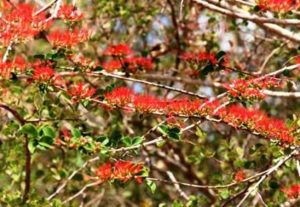
Combretum microphyllum. Photo: Petra Ballings. Source: Flora of Zimbabwe
Other members of the party were more observant as far as the game was concerned but had no reply when we asked if they had the Acacia nigrescens! Fringing this area were stately Hyphaene petersiana, the northern Ilala palm. Acacia robusta and the distinctive African mangosteen, Garcinia livingstonei with its arms of dark green foliage radiating from the centre. They, too, were in flower but it is small and white and insignificant. Shrubs of the shaving brush combretum, Combretum mossambicense with its white flowers sticking up above the foliage resembling shaving brushes and lots of Friesodielsia obovata bushes which must provide awealth of food when in fruit. A soft grey leaved spiny bush its showy flowers with a cluster of pale yellow anthers Capparis tomentosa was also very much in evidence. We caught a glimpse of the river and then the road wound away and onto higher ground with a whole new collection of trees and shrubs. Mixed woodland and the fringe of the Jesse forming an arch above the road were mostly dry branches but still suspended like dried decorations on a brown Christmas tree were the pods of the wooden pear, Schribera trichoclada. The crocodile bark diospyros, Diospyros guiloensis showed up distinctly with its grey bark and dark green leaves and Lonchocarpus bussei with a profusion of sprays of mauve pea-like flowers at the top of the tree but no leaves. Finally some more Colophospermum mopane woodland with well grown trees evenly spaced, the ground a beautiful russet carpet from their fallen leaves. G camp is right on the river its entrance is flanked by a magnificent Kigelia africana its fresh spring leaves a welcome sight after the dust of the journey and so was the beer.
It was a 6 hour trip, two of the Land Cruisers had punctures and one and a half kms from the camp Keith’s lorry broke down and they had to ferry the essentials to the camp. Later it was towed into camp and there was much concern over its breakdown, until Jim was asked to listen to a “funny” noise. He immediately pin pointed the problem to the alternator which had seized and which was very much less serious than the original diagnosis of an engine seizure. It took us all afternoon to set up camp but we were so intrigued by the valley it did not seem that long.
’The camp nestles under large Lonchocarpus capassa trees, several beautiful, Combretum imberbe, a flaming combretum, C.microphyllum just coming into flower over the top of the water tank. On the shore was a healthy young Acaciac albida home to many twittering birds. In the shrub layer round the camp Capparis tomentosa was in full flower. Sesbania sesban with green stripes on yellow flowers and Maytenus heterophylla were also seen.
The camp is well provided for with flush loo, shower and basin, kitchen with a sink and the cooking was done on an open fire. There is a main covered room for storage, where the deep freezes, fridges, coolers and tables were set up. There are two bedrooms, with doors and window. The rest of the party pitched tents. The water pump proved a problem but with lots of farmers their combined expertise got it working. But bathing arrangements were not set up that evening so we bathed in the river in small off shoot of swift flowing water, much hilarity was heard from the various couples who went down to wash. Rather magical in the fading light except I dropped the soap almost immediately and had no hope of retrieving it!
All of us slept better than we had for ages and woke at first light to the burbling of the Burchells coucal, joined by various doves, bulbuls and the wonderful melodious song of the collared palm thrush. The hunters set off early and the rest of us completed storing food etc. We went to launch the boats further up river where the first Tamarindus indica stood out near the water, The first fishing parties set off and were very successful. Landing an appreciable number of Tiger fish some vundu, nkupi, bream and squeakers ugh. Lunch and breakfast were movable feasts and dinner a wonderful meal at a long table set under the trees and stars which became more protracted and convivial as the weeks progressed. Jenny’s menus were superb and we partook of the hunters‘ spoils eating Impala steak and kidney, buffalo or impala neck soup, buffalo tail, impala brains crumbed, liver for breakfast, Impala roast superbly roasted underground. We also enjoyed Tiger fish cakes and grilled bream.
Ben took us on several game drives in the evening which gave us a chance to see more trees as well. Another tree in full flower was the striking Cassia abreviata. Afzelia quanzensis was recognizable from the odd pod left on an otherwise bare tree. In the centre of a Commiphora karibensis grove was a large fig with a wonderful green crown, Ficus natalensis_? In the mixed woodland area, referring to P.R. Guy’s paper on vegetation types in the Zambezi valley, we found three spp of Strychnos. S. potatoruzn the gape Strychnos, S.madagascariensis its large fruit a distinctive blue green and S.innocua with smaller green/yellow fruit. Cassine matabelica was in fruit and further from the river there -was the large leaved Cassine schlechteriana and Gardenia resiniflua.
When the hunters had got their buffalo, Ben took Jim and me with Larry and the trackers. We drove to the Zumbo river through miles of thick Jesse bush on the middle road. There were wonderful huge specimens of Diospxros mespilifomis along river banks also Kigelia africana and Cordyla africana in flowera plus many others. Larry shot two guinea fowl and two crested francolin for the pot, and walking along a river bed disturbed a leopard.
Another day Larry, Ben and I set off in the opposite direction towards the Chewore River. Larry got two impala near the river and we travelled through miles of Mopane woodland very bare of grass and in the shrub layer only Boscia mossambicensis and a small grey leaved shrub which were later interspersed by some specimens really beaten up by elephant.
Along the Chewore we drove through groves of Croton megalobotrys with C.gatissimus evident from its yellow autumn leaves and several shrub combretum forming a haven for guinea fowl and francolin. Then as we got close to the river huge Trichilia emitica and Kigglia africana towered above us. Kigelia africana was in flowerand the large blooms had fallen on the ground. A tasty meal for the impala. Rounding a corner we saw a huge Trichilia emitica with a Combretum microphyllum in full flower over its crown. We stopped on the banks of the Chewore and Ben suggested Larry took me for a walk to a spring which trickled out of the rock a few hundred metres away. A little way along we stopped within 10 meters of a sleeping lioness. She stood up to look at us and then trotted off. We later saw her cross the river bed in front of us. We also saw Nyala and kudu. Ficus sycamorus, in new spring leaves grew near the bank and shrubs of Balanites maughamii. Trichilia emitiea on the banks was also in flower. On the way home Larry spotted Adenium obesum flowering in the Colophospemum woodland what a contrast its striking pink flowers in the browns and russets and none of the party had ever seen it in the valley before.
Another memorable was spent sitting beside a pan while Larry painted, I sketched and watched a procession of birds and animals come down to drink. Jameson’s fire finch, Meyers finch and blue waxbills darted in and out of a thick shrub, a baboon strolled by, shinned half way up a tall tree and surveyed us from a branch! A pair of delicate bush buck came gingerly down, later three Nyala, two does and a fawn. Then with much chucking and running back and forth a flock of 16 crested guinea fowl, amusing birds with their black feather crests. The pan was fringed with Diospyros mespiliformis, Adansonia digitata, Combretum imberbe Euphorbia ingens, Acacia robusta a thick shrub layer of dried entangled branches. Climbing Combretum kirkii and many unidentified shrubs and trees.
On the Zambian bank delightfully uninhabited was a forest of young Acacia albida about 15 years old. One day we watched a family or about 8 e1ephant splashing in the river and than climb out have a sand bath and then pluck apple ring pods from a large A.albida.
You may have thought two weeks was time enough, but there were never enough hours in the day to complete everything. Our trip home was uneventful thank goodness after hearing stories of elephant tearing out of the bush to beat up vehicles. It was certainly one of the best holidays we have ever had. Our final list of trees identified was about 60 so but I am certain we are far short of what is there.
We also caught some fish says Jim.
-Ann C. Sinclair
For anyone interested in botany in general Linda and I and Robert and Andrew like getting out into the bush preferably in the Central Division. We go on camping trips or stay at National Parks, afternoons or long weekends, close to Harare and further afield, planned or on the spur of the moment. If you are interested in this sort of trip keep asking me what we are doing next – or have any ideas or want us to come with you give me a ring, our new phone number is 745263. Mark Hyde.
ANDY MACNAUGHTAN CHAIRMAN


